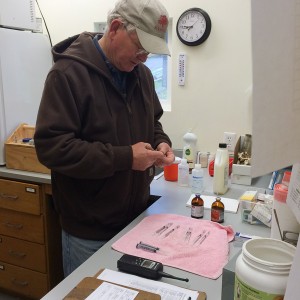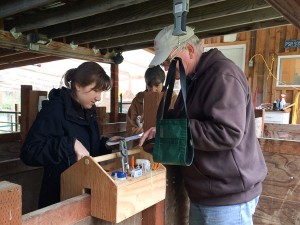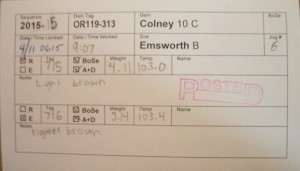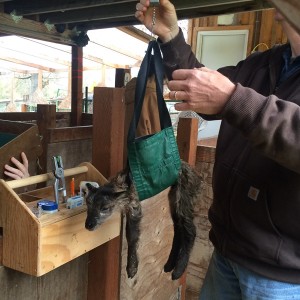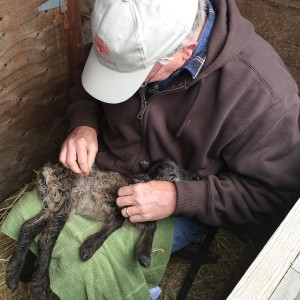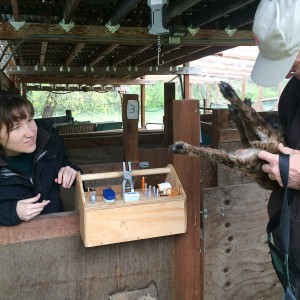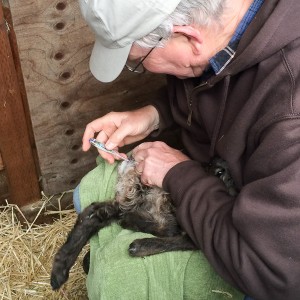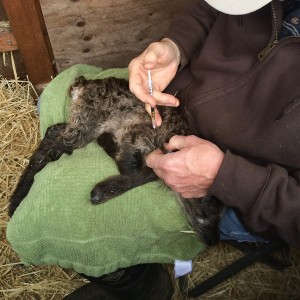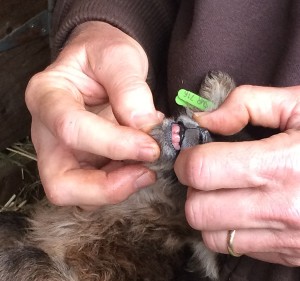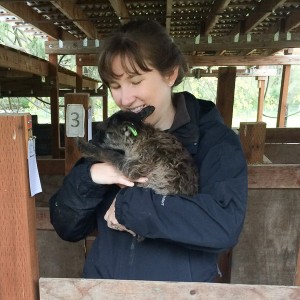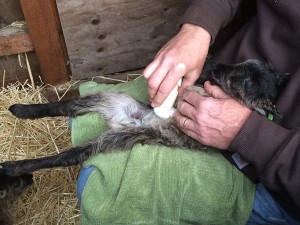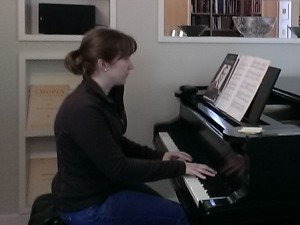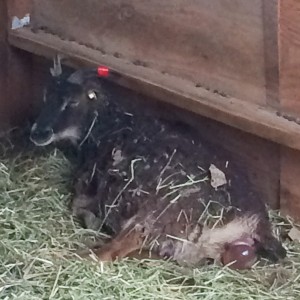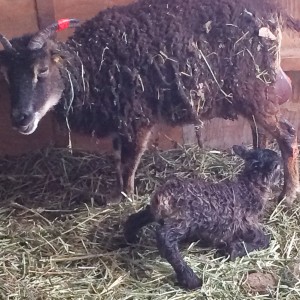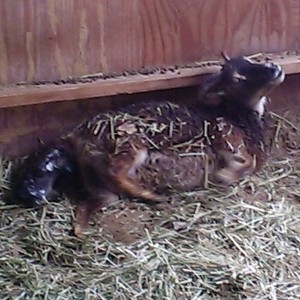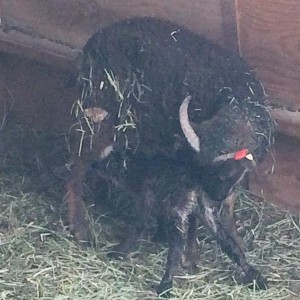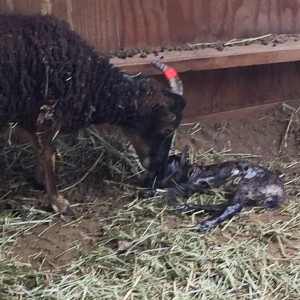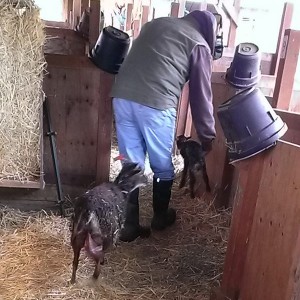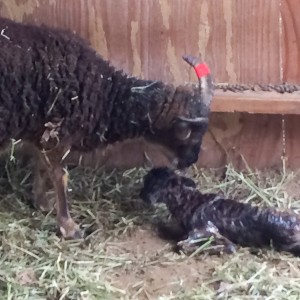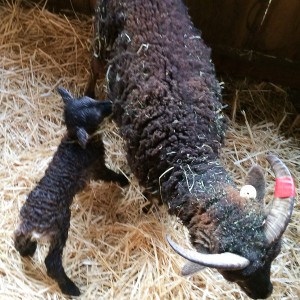Lamb Camp Day 2: It’s all about the lambs and how to “work” and enjoy them
For those of you who landed on this post looking for how to “work” a newborn lamb, or how a Soay ewe manages to nurse her first twin while the second one is coming out the birth canal and greeting the world, let me reassure you that you have not landed in an alien universe. But you have landed right in the middle of the Saltmarsh Soay Sheep Ranch Lamb Camp 2015.
Unsolicited advice: If what you are looking for is help with twins or figuring out how to sterilize a lamb’s umbilical cord, keep reading here. If you are curious about what Lamb Camp is all about and what aspects of Lamb Camp you might appropriate to enhance the heritage sheep experience on your farm, you might want to start at the beginning by clicking here.
Author’s note: There are a lot of links in this post and here’s why. There also is a lot of information about the mechanics of, and reasons for, how we deal with birthing and with working newborn lambs. Whenever possible, I tried to summarize the issues here and then send readers, via links, to more detailed discussions in more technical posts.
It had been a dark and stormy night, but that didn’t phase our Soay ewes. By the time Ida and Steve headed over to the Maternity Ward in the rain a little after first light, Shawn had moved two sets of overnight twins and their mothers, Colney and Cameron, to jugs. As for the still-pregnant ewes, Patterdale raced around bleating loudly, apparently having decided one of the twins from one of the mothers was hers. On our farm, this phenomenon is known as the “nosy aunt syndrome.” It usually means the bleating “aunt” will lamb within 24 hours.
Whitney and Audrey had just gotten their first cups of coffee when Steve’s voice came over the walkie-talkie with news of the overnight arrivals. Off the girls went, with Audrey particularly eager to have her first look at Soay lambs in the daylight. Meanwhile, I put breakfast of cheesy eggs (ours) on hold, answered an email from a potential customer wanting to visit in May, and awaited developments. Sure enough, Steve soon radioed, soto voce but with evident delight, “You should see Ida, the veteran Lamb Camper, providing the tour and explanation of how all this works.” That was all it took to send me out the door as well. I didn’t want to miss the fun.
Turns out one of the new mothers, Colney, was throwing a hissy fit. For some reason she tried to bash down the jug walls. There was no excuse for her behavior. It’s not as if she’s a beginner at this stuff; this was her third lambing. She actually knocked out two wall boards and when Steve went in to work her twins, she turned on him and had to be isolated temporarily in another jug. We are talking needles and glass thermometers here, after all. Data point: we have had between 400 and 500 lambings on our farm (700+ lambs); Colney is only the second ewe to pitch a fit in the jug. Our experience certainly supports the Conventional Wisdom that says Soay ewes are calm mothers.
I cannot remember whether I mentioned in the introductory Lamb Camp post that Audrey is a first grade teacher. Aunt Ida had told Audrey about her weekend here in 2013 and Audrey had shared Ida’s effusive emails and pictures with her students. This year, Audrey’s school could not have been more supportive of her own visit to Lamb Camp, even giving her time off for the trip. And so it was not at all surprising that Audrey wanted to learn everything she possibly could about all the aspects of lambing she could cram into 2+ days. The next series of pictures show Steve working Colney’s twins and Audrey acting as scribe, with other duties as assigned.
How we work Soay lambs at Saltmarsh Ranch
1. When to work the lambs. Once the ewe and her lamb(s) are in the jug, we can work them at any time during the next several hours. For example, if the lambs were born in the middle of the night and we find them in the morning, they will have had several meals and naps and be ready to work. If the new little “family” has just arrived in the Maternity Ward when we jug them, we usually wait a couple of hours for them to settle down before we intrude. In Colney’s case, she had had at least a couple of hours with her lambs and, given her attitude, Steve wanted to work her lambs and retreat as soon as possible!
2. Equipment and supplies for working lambs. We have discussed this issue repeatedly, including directly in a now-outdated post from my first year of blogging, and again in an updated and more detailed essay on the website proper, so a couple of pictures should suffice here:
3. Lamb cards. Although I have written about lamb cards before, I suspect the pictures of lamb working will make more sense if I review the lamb card briefly first.
As with baseball cards, lamb cards are nothing more than typed and filled-in data repositories. The printed portions of the card come straight from our sheep database, powered by Breeder’s Assistant software as heavily modified by my resident Data/Computer Geek, a.k.a. Steve. We know ahead of time that all lambings will happen in 2015, although we do not know in what order. We include the mother’s eartag number to be absolutely sure we have the right card for the ewe occupying the jug. Knowing the ewe’s age (the digits after her name) reminds us whether she has experience in the ancient rituals of lambing. We added the sire’s name, and both adults’ bloodlines, when we began using our customized version of the ALBC conservation breeding scheme, mostly so that we could comment from the get-go on the sterling qualities of the “linecross” ram lambs (our future flocksires).The rest of the information on the lambing card gets filled in while we work the lamb(s). As you can see from Colney’s card, there was nothing alarming or noteworthy about her lambs. The “notes” field is the place we record things like “big twink” or “white face” or “light phase” or “virtually black.” We also note immediate health issues here such as “raw patch on belly” or “slow starter” or even “stillborn.” Over the years, we have been surprised at how often these original notes provide useful, cautionary, or humerous information. For example, if we note on the card that the mother (usually a first-timer) tried to bash her lamb (Coda did this in 2006), the next year we will red-tape her horns to monitor her behavior when she lambs. After Colney tried to take off Steve’s kneecaps last week, I went back and looked at her prior lambing cards. Sure enough, sixteenth lambing in 2013, Shawn’s handwritten note: “Lamb happy, ewe good mother, but MEAN! Went in to check sex of lamb, ewe butted me HARD! – BEWARE!”
I guess we need to add “check ewe behavior histories” to our pre-lambing routine next year, and I need to add a note to Colney’s 2015 lamb card.
4. A pictorial guide to working Soay lambs. For details on any of these steps, click here for written explanations, and here for a EweTube of Steve working a lamb a few years ago.
Stage 1: weigh, optional fleece demo, gender check.
Stage 2 (lamb across Steve’s lap): temp/anti-pinning, eartag, shots.
Stage 3: optional tooth demo, optional cuddle, iodine navel.
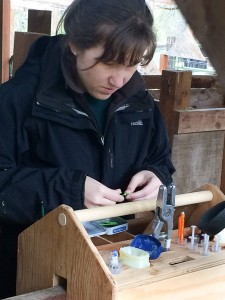
Baby Dalton eartags are a bear to get into their applicator, but just perfect for small breeds of sheep.
At some point in these proceedings, Ida remembered her gooseberries and hightailed it back to the house to make pie. How many people do you know who have a gooseberry bush in their back yard? How many of them carry enough frozen gooseberries from last summer all the way across country, at risk of being busted by the TSA monitors, in order to make a pie to celebrate lambing? I know one, thank goodness. Ida makes a worthy gooseberry pie. I’m thinking seriously about adding a “Recipes for Lamb Camp” post, or at least adding the recipes to the recipes section on our farm website and linking to them from here. But first I have to finish this series of posts, get permission from the Saltmarsh Ranch Webmaster (who doubles as the Data Geek and the Head Shepherd — he wears a lot of hats) to add non-lamb recipes, and tend to all the other projects that I’ve put aside to enjoy lambing. Stay tuned, again.
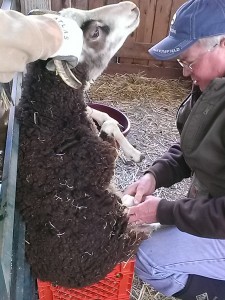
Poor Satterleigh, suffering the indignity of being hoisted up onto a milk crate just so she could endure having her own milk extracted
In retrospect, we were lucky there were no lambs during the day, as there was a lot to do — four lambs to work, including lots of background information for Audrey and Whitney, as well as the Satterleigh issue, and of course sidebars with Alfie up in the lamb play area.
Eventually things settled down and everyone but Steve went back to get dinner ready, the girls perched on chairs and stools in the kitchen, iPhones in hand, simultaneously chattering and talking over each other about the wonders of lambing and madly clicking away to catch up on email to and from their families back home, messages from work, and what not. Audrey even treated us to a concert, including Clair de Lune (“Moonlight,” how appropriate is that?), while Ida and Whitney set the table. We were about to sit down to a dinner of spaghetti and meatballs from the freezer made with our lamb, a big salad and sweet winter carrots from a nearby vegetable farm, and of course gooseberry pie, when Steve radioed that Patterdale (she of the early-morning bleating) was about to lamb. Off went the stove, into the pockets went the iPhones, and away we went.This was to be Audrey’s first lambing, and what could be sweeter than to have our special former bottle baby take center stage? Because I can never say enough about Patterdale, and I know Audrey will want to share this experience with her first graders, and no one had a video camera on, this birthing comes to you in a series of still shots. Click on each photo to enlarge it and see the explanatory text.
Is it any wonder that when we finally got back to the house for dinner, there was much happy talk about the similarities between our ascription of human-like qualities to virtually anything associated with our flock and the behavior of the animals in Charlotte’s Web? I am chagrined to confess I never read it as a child, too busy practicing piano I guess, so I tried to start it that night but fell asleep after only a few pages. What a sweet, sweet day with our Babes in Soayland!
On to Day 3. I hope you’ll join me in reliving the last full day of Lamb Camp 2015 … as soon as I get it written.
For now …
